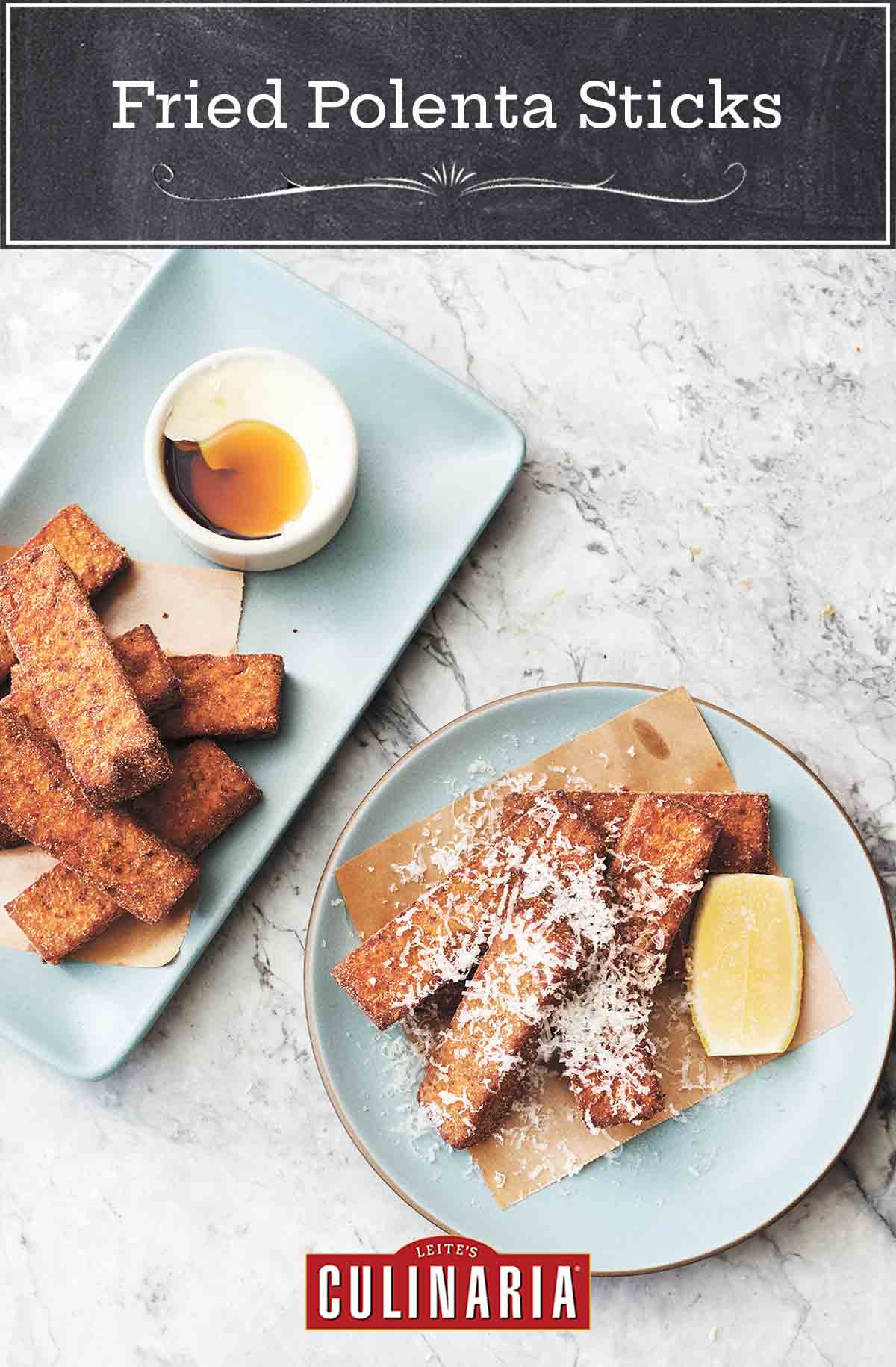
Aside from a big bowl of perfect polenta by itself, or with a dollop of ragù on top, a stick of fried polenta with a tasty topping is just about the best expression cornmeal can have. Make this using leftover polenta or cook up a pot of polenta expressly for frying these sticks. It will last in the fridge for up to 4 days (before you fry it), so you can make a batch and then serve them a couple of times during the week.–Joshua McFadden
Fried Polenta Sticks FAQs
Ideally, you want to use a neutral-tasting oil, with a high smoke point, such as safflower, sunflower, or grapeseed. In a pinch, you can use virgin olive oil.
Polenta is made from a coarsely ground variety of corn that’s ideal for creating the creamy porridge we know and love. Cornmeal refers to ground corn and can come in a variety of textures ranging from very fine to coarse. While any medium or coarsely ground cornmeal will work for making polenta, it’s worth the effort to seek out products specifically labeled as ‘polenta’.

Fried Polenta Sticks
Ingredients
For the polenta
- 1 cup stone-ground cornmeal
- 1 teaspoon kosher salt, plus more if needed
- 1 quart water
- 2 tablespoons (1 oz) unsalted butter
- About 1/2 cup grated Parmigiano-Reggiano or pecorino cheese, or other cheese of your choice, or more to taste (optional)
For frying
- Mild vegetable oil or olive oil, for frying
- 1 garlic clove, smashed (optional)
- 2 to 3 sprigs fresh thyme or rosemary (optional)
For serving (optional)
- Romesco sauce and chopped fresh cilantro
- Ragu sauce
- Grated Parmigiano-Reggiano or pecorino cheese
Instructions
Make the polenta
- Put the cornmeal and salt in a large heavy-bottomed pot and slowly whisk in the water. Bring the mixture to a boil over medium-high heat and then adjust the heat so the polenta just barely simmers when covered. Be careful, because the polenta will spit like lava, and it’s just about as hot!
- Cook over gentle heat, stirring often with a long spoon or stiff silicone spatula, making sure to scrape the bottom of the pot and into the corners. Continue to cook until the cornmeal has fully expanded and doesn’t feel at all crunchy when you take a bite and the polenta pulls away from the sides of the pan, anywhere from 45 minutes to 3 hours, depending on your polenta.
- Stir in the butter and cheese, if using. Taste, and adjust with more salt if needed.
- Pour the cooked—but still fluid—polenta onto an oil-rubbed half sheet pan or 9- by 13-inch (23- by 33-cm) baking dish. You want the polenta sticks to be about 1/2 inch (1.25 cm) thick, so choose a pan that suits the amount of polenta you have.
- Let the polenta cool and firm up, about 25 minutes. When completely set, flip it out onto a cutting board and cut into strips the size of fish sticks, or whatever shape you like.
Prepare your toppings (optional)
- If using toppings, get them ready before you start to fry.
Fry the polenta
- Arrange a layer of paper towels on a baking rack, tray, or plate to drain the polenta sticks.
- Pour 1/4 inch (6 mm) of oil into a wide skillet and heat over medium-high heat. If desired, add the garlic and herbs to the oil as it heats, to flavor the oil. Use a slotted spoon to remove the garlic and herbs before frying the polenta.
- Working in batches, carefully arrange a single layer of polenta sticks in the pan with enough room in between so you can slip the spatula in. Fry until each side is golden brown and the polenta sticks are heated through, about 4 minutes per side. Don’t try to move the sticks for the first minute of cooking, or they may stick to the pan.
- Drain for a few seconds on the paper towels, then serve right away, with the topping of your choice and a shower of grated cheese, if desired.

Nutrition
Nutrition information is automatically calculated, so should only be used as an approximation.
Recipe Testers’ Reviews
These fried polenta sticks made for a delicious change to our normal dinner repertoire. The polenta sticks are crunchy and creamy and overall quite delightful. As I wasn’t sure what to expect I made a half batch and am regretting that decision as I type up the review, especially as the cooked polenta would keep in the fridge for a few days.
If you are starting out with the polenta cooked already the recipe takes minimal prep time, just the time to cut the polenta and heat the oil. It took the cooked polenta about 25 minutes to cool and solidify before cutting. I did as suggested and added a clove of garlic and some fresh rosemary to the oil. I served the polenta with freshly grated Parmigiano and lemon and a garlic sauce.
These fried polenta sticks are a tasty option to use leftover polenta. The end result was a firm crusty outside with a creamy middle. This is a good side dish to any dinner or served with maple syrup for brunch.
Crisp on the outside, soft and creamy on the inside, these fried polenta sticks were the perfect accompaniment to the red wine beef stew I served and received rave reviews. While I did not add any cheese to the polenta, I can imagine some great combos – adding pepper jack and serving these with chili, adding Cajun seasoning and serving with gumbo, the list goes on. These would also make a great appetizer to go with drinks.
The recipe for both the sticks and the polenta itself was easy to follow with accurate timing and cues. My only recommendation is to use the pan with the highest sides you own because the frying caused a lot of spatters (but well worth the clean-up).
I received this cookbook for Christmas and had already made the soft polenta and served with a braised chicken dish, again to rave reviews. All in all, a high reward recipe.
We used leftover polenta, as suggested, prepared by following the directions about pouring into an oiled pan and making sure to keep the thickness at about 1/2 inch, and then refrigerated, also as suggested.
After frying, the draining took place on paper towels set atop a cookie rack which helps to keep fried foods from getting soggy. Because the original soft polenta had no cheese, the topping of choice was CHEESE, and plenty of it, and the specific cheese was a hunk of made in Wisconsin Parmesan.
This is a perfect winter comfort food, and as the temperature here in Chicago has warmed up to a balmy 12 degrees, we could, as the recipe suggests, make a batch and then serve them a couple of times during the week – this could easily be our winter go-to for a snack after spending time outside; for one part of lunch, perhaps with a salad; or for a dinner appetizer, and yes! all of these in the same week would be just fine! In my dreams, I’m eating this after coming inside from a ski village in the mountains; in reality, this would be great to make (and it’s quick and easy!), after coming inside from running errands in the snow.















Fried corn meal mush. Growing up we would get corn meal mush for breakfast and the leftovers would be poured into a greased loaf pan, cooled and sliced and fried. Sometimes topped with cheese, or served with a side of apple sauce or for breakfast with maple syrup.
Always fried in bacon grease.
Thanks, Vincent! A little bacon grease and maple syrup, sounds perfect.